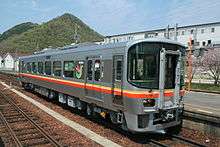KiHa 122 series
The KiHa 122 series (キハ122系, Kiha-122-kei) and KiHa 127 series (キハ127系, Kiha-127-kei) are diesel multiple unit (DMU) train types operated by West Japan Railway Company (JR-West) on the Kishin Line between Himeji and Kōzuki. A total of 19 cars have been delivered, formed as seven single-car KiHa 122 series units and six two-car KiHa 127 series units.[2] Test-running commenced in late September 2008,[4] with the units entering revenue-earning service from the start of the revised timetable on 14 March 2009.[5]
| KiHa 122/127 series | |
|---|---|
 KiHa 127 series 2-car DMU at Himeji Station in March 2009 | |
| Manufacturer | Niigata Transys[1] |
| Constructed | 2008–2009 |
| Entered service | 2009 |
| Number built | 19 vehicles |
| Number in service | 19 vehicles |
| Formation | KiHa 122: Single car unit KiHa 127: 2-cars per trainset |
| Capacity | KiHa 122: 113 (33 seated) KiHa 127: 268 (92 seated) |
| Operator(s) | JR-West |
| Depot(s) | Himeji |
| Line(s) served | Kishin Line |
| Specifications | |
| Car body construction | Stainless steel |
| Car length | 20,440 mm (KiHa 122) 20,270 mm (KiHa 127) |
| Width | 2,900 mm |
| Height | 4,040 mm |
| Doors | Two pairs per side |
| Maximum speed | 100 km/h (60 mph)[2] |
| Prime mover(s) | SA6D140HE-2[3] |
| Power output | 450 hp (at 2,100 rpm)[3] |
| Transmission | Hydraulic |
| Train heating | WAU707 x2 |
| Bogies | WDT65 (driving), WT248 (trailing) |
| Braking system(s) | Engine brake, electronically controlled pneumatic brakes |
| Safety system(s) | ATS-SW |
| Track gauge | 1,067 mm (3 ft 6 in) |
Exterior
The body design features improved crash resistance, based on the recent 223 series electric multiple unit design. The cars use environmentally-friendly diesel engines with reduced NOx and particulate emissions.[6]
Externally, the units are finished in unpainted metal with thin yellow and red waistline stripes.[4]
Interior
Internally, the cars feature flip-over reversible seating arranged 2+1 abreast. Toilets in both types of train are wheelchair-accessible, and the step between the passenger compartment and station platform has been eliminated.[6]
 KiHa 127 interior
KiHa 127 interior KiHa 127 forward view showing LED fare board for wanman driver-only operation
KiHa 127 forward view showing LED fare board for wanman driver-only operation KiHa 127 toilet
KiHa 127 toilet
Formations
The KiHa 122 single-car units and KiHa 127 two-car units are formed as follows.[7]
KiHa 122 series (single-car unit)
The KiHa 122 series uses a diesel engine with a small lithium-ion battery (18 kWh) that is used to power auxiliary machines in the train.[8]

| Designation | cMc |
|---|---|
| Numbering | KiHa 122-0 |
| Weight (t) | 40.5 |
| Capacity Total/seated |
113/33 |
(Equipped with toilet)
KiHa 127 series (2-car units)
| Designation | Mc1 | Mc2 |
|---|---|---|
| Numbering | KiHa 127-0 | KiHa 127-1000 |
| Weight (t) | 38.5 | 37.5 |
| Capacity Total/seated |
130/41 | 138/51 |
(KiHa 127-0 is equipped with a toilet.)
Derivatives
- ET122, single-car DMUs for use on the third-sector Echigo Tokimeki Railway Nihonkai Hisui Line since March 2015
References
- キハ127+キハ122,網干へ回送 [KiHa 127 & 122 moved to Aboshi]. Japan Railfan Magazine Online (in Japanese). Japan: Koyusha Co., Ltd. 2 October 2008. Retrieved 14 March 2012.
- JR西日本 キハ122形・キハ127形を姫新線に導入 [JR-West to introduce KiHa122/127 on Kishin Line]. Tetsudō Daiya Jōhō magazine. Vol. 37 no. 294. Japan: Kōtsū Shimbun. September 2008. p. 70.
- キハ122・127系 気動車 [KiHa 122/127 series DMU]. Japan Railfan Magazine. Vol. 49 no. 573. Japan: Kōyūsha Co., Ltd. January 2009. pp. 68–72.
- キハ127+キハ122が試運転 [KiHa 125 + KiHa 122 Test run]. Japan Railfan Magazine Online (in Japanese). Japan: Koyusha Co., Ltd. 22 September 2008. Retrieved 14 March 2012.
- Yomiuri Shimbun: 新型高速ディーゼル登場姫新線 (15 March 2009). Retrieved on 18 March 2009 (in Japanese)
- キハ122、127系気動車の新製投入について [Introduction of new KiHa 122/127 series diesel cars]. Press Release (in Japanese). Japan: West Japan Railway Company. 26 August 2008. Archived from the original on 15 January 2009. Retrieved 14 March 2012.
- Nishiwaki, Kōji (January 2011). JR各社の新世代気動車の現況 JR西日本キハ122・127形 [The Current State of Modern JR DMUs - JR-West KiHa 122/127]. Japan Railfan Magazine. Vol. 51 no. 597. Japan: Kōyūsha Co., Ltd. pp. 108–110.
- Yamamoto, T. (2017). "Trends and Recent Studies on Hybrid Railway Vehicles". Quarterly Report of RTRI. 58 (1): 1–5. doi:10.2219/rtriqr.58.1_1.
External links
| Wikimedia Commons has media related to KiHa 122/127. |
- "Archived copy" (in Japanese). Archived from the original on 15 January 2009. Retrieved 27 August 2008.CS1 maint: archived copy as title (link)
- JR-West KiHa 122/127 series (Japan Railfan Magazine) (in Japanese)